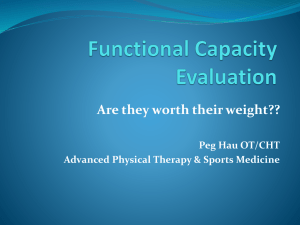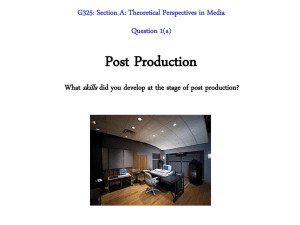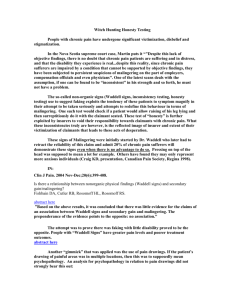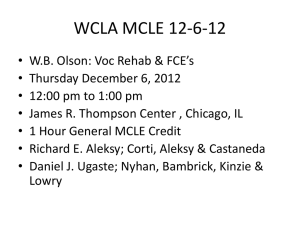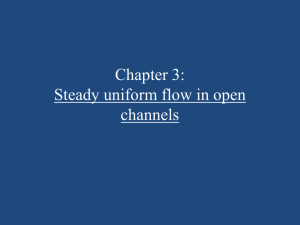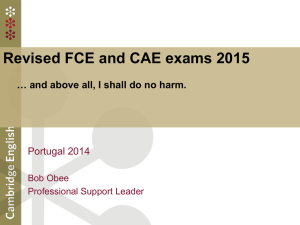work conditioning vs. work hardening
advertisement
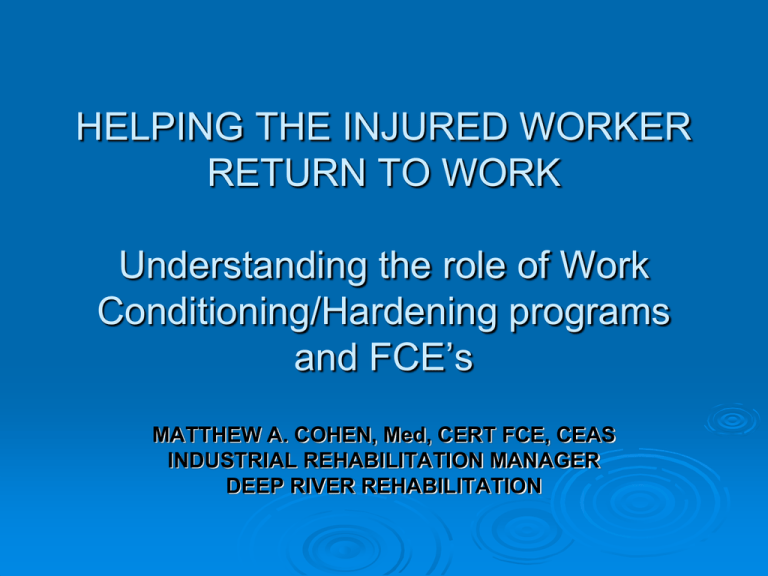
HELPING THE INJURED WORKER RETURN TO WORK Understanding the role of Work Conditioning/Hardening programs and FCE’s MATTHEW A. COHEN, Med, CERT FCE, CEAS INDUSTRIAL REHABILITATION MANAGER DEEP RIVER REHABILITATION WORK CONDITIONING VS. WORK HARDENING MATTHEW A. COHEN, Med, CERT FCE, CEAS INDUSTRIAL REHABILITATION MANAGER DEEP RIVER REHABILITATION FUNCTIONAL CAPACITY EVALUATION MATTHEW A. COHEN, Med, CERT FCE, CEAS INDUSTRIAL REHABILITATION MANAGER DEEP RIVER REHABILITATION BACKGROUND 12 YEARS OF EXPERIENCE INDUSTRIAL REHAB CERTIFIED FCE EVALUATOR (BLANKENSHIP) CERTIFIED ERGONOMICS SPECIALIST BACHELORS SPORTS MEDICINE MASTERS EXERCISE PHYSIOLOGY FATHER OF 2 (KIDS) OUTLINE INDUSTRIAL ATHLETE COMPONENTS OF WORK COND. & WORK HARD. CRITERIA TO DETERMINE WHO IS APPROPRIATE CANDIDATE. GOALS OF PROGRAM (FUNCTIONAL VS. SUBJECTIVE). WHAT IS AN FCE? TYPES OF FCE’S VALID VS. INVALID WHAT NEXT? USING OUTCOMES OF WC/WH AND/OR FCE FOR RETURN TO WORK. OPEN DISCUSSION Work Disability Cycle EMPLOYEE INJURED RTW ER REHAB Care Manager OMC PT SPECIALIST PCP POOR TECHNIQUE POOR POSTURE POOR DECISIONS Bad Decisions www.medicine-in-motion.com INDUSTRIAL ATHLETE As time off work is inversely correlated to the rate of return to work, early intervention is strongly recommended. WHY WE NEED RTW PROGRAMS Research shows employees receiving disability benefits recover less quickly and have poorer clinical outcomes than those with the same medical conditions, who do not receive disability benefits. employees that had no lost time from work had better outcomes than employees who lost some time from work. odds for returning to full employment decreases 50-50 after six months of absence. Costs of Work Injuries $142 billion annual Worker Compensation costs in 2009. Per claim cost average $7,000 to $30,000 There is a wide range in cost per claim among companies (how managed) EDUCATION OF EMPLOYEE 80 to 95% of injuries are due to poor choices and habits. Liberty Mutual study found that 68% of accepted claims are related to ergonomics and/or body mechanics. Industrial Rehabilitation goes beyond just treating the injury it also includes vital safety information to the client. MYTHS The 100 Percent or Nothing Myth: Employees must be able to do 100 percent of their job tasks before returning to work. Reality Not so. Employees regain their ability to work incrementally and can therefore transition back into the workplace gradually. In most cases, work tasks can be modified for short periods of time without reducing the overall productivity of an organization. MYTHS The Light-Duty Myth Light duty is an effective way to return employees to their full productivity. Reality Light duty can be static and open-ended. Uncontrolled or poorly managed light duty can encourage an employee to remain in a reduced-productivity position too long, or indefinitely. Without a planned transition back to full productivity, employees will not become reconditioned or build up the tolerance they need to resume full job duties. And if appropriate expectations are not established on the front end, miscommunication between the employer and employee can occur. DISGRUNTLED MYTHS The Total-Disengagement Myth People who are ill or injured need total rest and removal from everyday life in order to recover. Reality People heal from illnesses and injuries incrementally. Getting back to normal daily activities, including work, is part of that process. Recovery progresses quickly and successfully when there is a combination of early mobilization treatment and increased transitions back to a normal way of living. Rehab team plays a key role in the recovery process when they involve the physician and the employee in return-to-work planning and a discussion of the need for temporary modifications in the workplace. NEED TO AVOID SICK MENTALITY MYTHS The Physician-as-Occupational-Expert Myth Physicians always offer work restrictions based on solid knowledge of job demands and know when a patient is ready to return to work. Reality Physicians are experts in the field of diagnosis and treatment of disease and disability, but need objective data in order to make wellinformed return-to-work assessments. A physician isolated from this data may unnecessarily limit the patient’s work options. Usually, this is unintentional and the result of inaccurate or incomplete information. In some cases, a physician's training and work focus may not provide the best skills and clinical setting to assess functional capacity and make return-to-work plans. CONT. 50% of injured workers who remain off work 6 months or more never return to work 75% of injured workers who remain off work 12 months or move never return to work We need to treat them like athletes and give them every opportunity to succeed and return to work. What is Work Conditioning? “a work related, intensive, and goal-oriented treatment program specifically designed to restore an individual’s systemic, neuromuscular (strength, endurance, flexibility, etc.) and cardiopulmonary function.” The objective of the work conditioning program is to restore the client’s physical capacity and function so the client can “return to work”. APTA What is Work Hardening? “a highly structured, goal oriented, individualized treatment program designed to return the person to work.” Work hardening programs use real or simulated work activities designed to restore physical, behavioral, and vocational function. CARF (Provider Accreditation) Work Cond. Vs. Work Hardening Work Conditioning 2 - 4 hours a day 3-5 days a week 3-4 weeks Addresses systemic, neuromuscular, cardiopulmonary, and function Work Hardening 4-8 hrs. 5 days a week 4-8 weeks Addresses physical behavioral and vocation function Work Cond. Vs. Work Hardening Work Conditioning Easier to get Worker Comp approval. Due to the lower cost and number of days/wk usually can get more visits. Work Hardening More expensive Harder to get approval for initial visits and continuation of program. Both programs effective RESEARCH Function-centered treatment involved work simulation combined with cardiovascular workouts and strengthening exercises. Pain-centered treatment involved stretching combined with passive and active mobilization . The study concluded that function-centered rehabilitation is recommended more than pain-centered treatment. FCT decreased work-related disability and were part of the larger return to work group. 2005 study. Back Patients (Kool, Oesch, Bachmann, Knuesel, Dierkes, Russo, de Bie, van den Brandt). RESEARCH Research shows that problem-oriented rehabilitation can significantly reduce long-term sick leave (Streibelt, Blume, Thren, Reneman, & Meuller-Fahrnow, 2009). Consistent with that research, work conditioning programs are problem-oriented programs with the intent to return the individual to normal work function ASAP. High correlation between the patient’s attitude and success of returning to work. WHAT IS WORK CONDITIONING? *Work Conditioning is not just a continuation of physical therapy. *Work Conditioning is an effective adjunct to a comprehensive physical therapy program and effective RTW program. *Work Conditioning is entirely focused towards returning the injured worker back to work quickly and safely. What is Work Conditioning? It is a structured program of PHYSICAL CONDITIONING, ERGONOMICS training and EDUCATION in safe work practices. It addresses the individual needs of the injured worker as it relates to their return to a specific job or job type. It is a training program for the INDUSTRIAL ATHLETE. When is it Appropriate? Client requires progression from skilled PT (d/c from acute) Option if insurance will not pay for FCE Client currently unable to RTW & perform required job demands Strength/Endurance Deficits Per therapist's recommendation Per doctor's order Treatment option as result of FCE to increase ability to RTW It All Begins With an Injured Worker Very Appropriate Not Working. Working Light Duty. Inconsistency Demonstrated in PT. Attempted return to work and failed without WC. FCE shows strength as primary limitation. Non-compliant with HEP. DO YOU KNOW WHAT YOUR INJURED EMPLOYEE IS DOING? Acute Therapy is Complete, What next? Is the employee physically ready to return to work SAFELY? Depends on number of days not working regular duties?. What were they doing for light/modified duty? Are they still having pain that limits function? What is their confidence level? Are they professional W/C patients? (Need Motivation) AFTER PHYSICAL THERAPY INITIAL EVALUATION EVALUATE FUNCTION AND DETERMINE DEFICITS LIFT/PUSH/PULL, GRIP, CLIMBING, POSITIONAL TOLERANCE, ETC. MATCH TO PHYSICAL DEMANDS OF JOB (JOB DESCRIPTION/ANALYSIS) DEVELOP PROGRAM WITH FUNCTIONAL GOALS. STRUCTURED PROGRAM 3-5X PER WEEK 3-4 WEEKS(STRENGTH CHANGES) 2-4 HOURS PER SESSION CONSTANT MONITORING RE-EVALUATE EVERY 3-4 VISITS (ASSISTS IN ADJUSTING WORK RESTRICTIONS) GOALS Functional Goals vs. Subjective Goals Pain is not the focus Can you do more, and be productive? During initial Eval the client signs a consent which states intent for RTW. Try to establish 4-5 functional goals. Pain is monitored but not the focus. GOALS Clients focusing on pain should learn to accept that a quick resolution of their pain problem is not realistic, and that the primary goal of WC is restoration of function. In order to change the focus from pain towards function, weekly assessment of functional evolution and a formal feedback of the results for the client is critical. The clients should learn to really appreciate their functional improvements in spite of the fact that some pain is persisting. TREATMENT PROGRAM CARDIOVASCULAR COMPONENT (You lose it if you don’t use it) GENERAL CONDITIONING EXS. FLEXIBILITY EXS. JOB SPECIFIC WORK SIMULATION PATIENT EDUCATION (Body Mechanics, Posture, Pacing, Symptom Management) COMMUNICATION (Update MD on progress, case manager, plant nurse, HR) NEED TIME! All three parameters (intensity, duration, frequency) contribute to the training volume. The volume should exceed that which the muscles normally encounter. This “overload” induces muscles to adapt and progressively increase their ability to generate force. Muscle Physiology Work Conditioning WORK CONDITIONING Work Conditioning Don’t Lift With Your Back! Benefits of Work Conditioning An earlier, safer return to work A daily program that gets the injured worker “out of the house” and more focused on a daily program of work Self-imposed competitiveness among the participants, which motivates them to reach beyond their goals Increased socialization and less focus on pain and disability Increased confidence in returning to a job they once feared as a possible source of re-injury Documentation of inconsistencies Benefits of Work Conditioning Improves musculoskeletal status ROM, strength, endurance Increases functional abilities physical demand level, abilities, workplace tolerance Improves worker performance symptom management, symptom magnification, worker traits WORK SIMULATION Work simulation is the crucial part in the functional training of a WC program. It mimics many job situations, functional postures and tasks, so offering clients the opportunity of practicing work activities and procedures in a “therapeutic” framework, in order to train job-specific deficits step by step. Work Simulation The client is deconditioned: there is a big gap between actual functional capacity and the physical demands of the specific job; – lack of work-oriented goals in usual care and physical therapy (these treatments often are pain oriented and do not focus on prompt increase of work related functional capacity, nor do they include work simulation tasks, and they are usually not intensive); Ideal Situation Combining Limited Duty and Work Conditioning will maximize the worker’s Musculoskeletal, functional and worker performance. RETURN TO WORK Success less than 50% if off work greater than 6 months 25% if off greater than 1 year Nearly 0% if return to work has not occurred within 2 years The longer someone stays home the more severe they feel their injury is. THE CHALLENGE If patients do not come into Industrial Rehabilitation with the mindset of receiving care and returning to work as soon as possible, they are more likely to fail in attempts to complete a work conditioning program and return to full active duties. Try to establish positive mindset in acute phase. GOOD REHAB IS WORKING “Work is the grand cure of all maladies and miseries that ever beset mankind” Thomas Carlyle, 1866 “As long as we still get weekends off!” Matthew Cohen, 2008 SOMETIMES THE EMPLOYEE STILL ISN’T EAGER TO RETURN TO WORK WHEN THEY ARE READY PAIN When time of inactivity is kept short and use of passive modalities (physical agents, manual therapy, massage, etc.) is limited, individuals are less likely to develop symptom magnification and to assume a “sick role”. PAIN Clients focusing on pain should learn to accept that a quick resolution of their pain problem is not realistic, and that the primary goal of WC is restoration of function. In order to change the focus from pain towards function, weekly assessment of functional evolution and a formal feedback of the results for the client is critical. The clients should learn to really appreciate their functional improvements in spite of the fact that some pain is persisting. PAIN Important core messages to give the back pain client are: – chronic pain does not mean harm! It is not dangerous to move and stress your body when you are in pain! In fact, this is necessary in order to escape from the vicious circle of avoiding physical activity, loss of fitness and pain; PAIN – chronic pain usually cannot be reduced in a short time. However, it is possible to increase performance capacity with intensive training despite pain. In many cases, a reduction in pain will then occur in the long term; In Workers Compensation Life-Altering Decisions Are Made ! Safe Return to Work? Employability? Continuation of Treatment? Disability determination? Residual Functional Capacity? Implications of these decisions are enormous! Functional Capacity Evaluations FCE can help you make appropriate RTW decisions Objective Measures Provide Critical Information Save You Time Looks great! Does it have an engine?? ENTIRE MISSION OF TESTING IS: To prevent injuries To protect employer/employee To provide the best possible RTW conditions To maintain productivity FCE? Functional Capacity Evaluation, FCE, is a systematic evaluation process designed to document a person’s current work ability from a physical ability and motivational perspective with consideration given to any existing medical impairment and/or pain syndromes. It’s primary purpose is to determine a worker’s ability to return to work following a job related injury, to help determine an injured worker’s medical impairment to assist with the settlement of their case, to determine a person’s functional loss following a personal injury, and other elements dealing with the decision of an injured worker’s ability to work at certain levels of stress. TYPES OF FCE’s UEE JOB SPECIFIC NON-JOB SPECIFIC FORENSIC (All incorporate this) BASELINE FCE DISABILITY Without FCE... RTW Decisions Require a Lot of Guesswork! Client self-report Do you think you are ready to go back to work? Impairment/diagnosis-based Imaging studies Range of motions General impressions decision Problems with This Approach Self-report Is influenced by motivation • job satisfaction • financial incentives Impairment information Not equal to function No objective information about patients’ functional abilities! An FCE Can Help You…. Progress Treatment Match Abilities to Job Demands Make RTW Decisions Determine Work Restrictions Make Reasonable Accommodations Evaluate Performance Inconsistencies Facilitate Case Closure FCE Benefit to the Physician Provides an accurate summary of physical capacities Saves time Improves communication patient, employer, other providers Can be counted on in court FCE Benefit to the Case Manager Objective Reliable data to facilitate case closure Expedites work information for the rehab plan safe, productive return to How does the FCE report assist me with my patient’s case? Overall level of work Tolerance 8 hr day Level of cooperation Specific limitations Job match Interventions Job placement Work transition Barriers to address Modified duty needs Return to work decisions Program planning DISABILITY The World Health Organization defines disability as “any restriction or lack of ability to perform an activity in the manner or within the range considered normal for a human being” (resulting from an impairment). Disability is also the "gap between what the individual could do prior to the injury and is currently able to do". Disability represents the Functional Loss. IMPAIRMENT A permanent impairment according to the definition is “one that has become static or stabilized during a period of time sufficient to allow optimal tissue repair and one that is unlikely to change in spite of further medical or surgical therapy.” ROLE OF THE FCE The FCE process can help establish the Disability, but it is not a medical test that establishes a person’s Impairment. However, portions of the FCE process may be used in the impairment process, for example, Dynametric Muscle Testing may be used to document the extent of muscle weakness in a Shoulder Rotator Cuff injury after adequate time for recovery has taken place. IMPAIRED VS. DISABLED An impaired person may not be disabled. For example, a laborer may sustain an amputation of two fingers on his dominant hand, but may be able to perform their original job as a Machinist. But the same impairment on a Hand Surgeon or a Concert Pianist may be disabled from pursuing their vocations. FCE LOOKS AT NON-MATERIAL HANDLING Balancing Climbing Crawling Crouching Feeling Fingering Kneeling Reaching Sitting Standing Stooping Walking MATERIAL HANDLING Carrying Handling Lifting Pulling Pushing FCE INCLUDES The FCE should include the identification of client behaviors that interfere with the client’s physical performance. FCE INCLUDES The DOT Categories of Work include: SEDENTARY (Up to 10 lbs.), LIGHT (Up to 20 lbs.), MEDIUM (Up to 50 lbs.), HEAVY (Up to 75 lbs.) and VERY HEAVY (100+ lbs.) The Frequencies tested for are: NEVER (0%), OCCASIONAL (0-33%), FREQUENT (33%-66% and CONSTANT (66%-100%) The evaluation of the biomechanical components of safe work practices. The purpose of the FCE should be defined Goals of the FCE Answer the questions of the referral source: Can he work and at what level? Is there dysfunction/limitations? Can the worker return to a specific job? Was he trying his best? What is an FCE? A test to assist in determining an individual’s capacity for work. An FCE is a means to assist in case closure FCE’s are in many ways a behavior test Validity and Reliability Validity: Measures what it is suppose to measure Reliability: Consistent measurement. Can be reproduced. RESEARCH King et. al, identified the Blankenship method as one of three (out of the ten they reviewed), FCE testing systems utilizing both normative and objective data. The Blankenship method was also the only FCE testing system identified as being developed based upon published medial research. Brubaker et.al, (2007) identified four components of the Blankenship FCE system to demonstrated good sensitivity and specificity for detecting submaximal effort. No Standard in the Industry There has not been one test/system that has been proven the most reliable/valid for FCE’s. Must rely on current studies/practices and literature and utilize the best battery of tests available to obtain a good outcome. FCE needs to address: Material handling including: Lifting from floor to overhead Push/pull Carry Non material handling/positional tolerances Sit, stand, walk Bend, stoop, kneel and squat Performance is the key How can I “force” an injured worker to push harder than they are willing. When we start the FCE, the worker is instructed to “stay safe, work up to the safe maximum ability” Thus we are looking at behavior and performance I can’t say… Malinger Faker Symptom magnifier I can say… Acceptable effort Over guarding (fearful) May not represent true work capacity Can perform work at least at this level Will be safe to perform work at this level How do I determine this? Going to look at a variety of items including: Pain levels pre, during and post test AROM pre and post test Heart Rate and Rate of Perceived Exertion Psychometric testing Coefficient of Variance Kinesiophysical Signs Lifting Pain Scales Simply ask the client to report pain on the scale. If they report that pain is at 6 or above, but don’t want to take a break… At level 10 but still going strong? Heart Rate and RPE This is commonly called the BORG Ask client to rate exertion- “how much work hearts and lungs are doing” Compare Must to heart rate be aware of medications taking. Psychometric Tests Psychometric tests are self reporting pen and paper tests/questionnaires. They give the client an opportunity to rate/report their abilities and pain. Psychometric Tests Modified Oswestry Low Back Questionnaire Rates for scores are a result of study by Blankenship: scores of 40-100% are considered high and indicate significant impairment or symptom magnification scores of 0-29% are considered low and indicate non symptom magnification scores of 30-39% indicate an equivocal result Ransford Pain Drawing Again, another look at how this person perceives pain Sometimes do pre and post drawings Pain Drawing Score 0 Pain Drawing Score 4 Additional Questionnaires DASH SPADI Pain Disability Index Dallas KOOS Michigan Hand Outcomes FAAM Psychometric test warning These They tests cannot stand alone. must be used in conjunction with each other and the rest of the test Waddell’s Panel for Non Organic Signs A group of observations taken during specific tasks. These point to the presence of nonorganic factors causing back pain. Must have three of five groups to be considered positive. NON-ORGANIC Non-Organic Signs are mostly based on objective criteria, which are documented during a clinical musculoskeletal evaluation, based on peer reviewed research. They answer the question of whether or not the patient is cooperating with the musculoskeletal evaluation, and whether or not they are reporting sensory loss, weakness, tenderness and movement dysfunction, which are simply not present NON-ORGANIC TESTS 1. Gordon Waddell: 3/5 Positive for Low Back Pain 2. Greg Korbon: 5/21 Positive for Low Back Pain 3. Jerry Sobel: 3/5 Positive for Neck Pain (Waddell’s Score) 4. Modified Korbon: 5/21 Positive for Neck and Extremity Pain (Modified by Blankenship) 5. Additional Simulation Tests (Non-Published Placebo Tests) 6. Additional Distraction Observations (Non-Published and Restricted to M-S Evaluation Only) Movement Measure range of motion at beginning Why would it be better or worse at the end of the test? Better if need to “loosen up” Worse if in pain. What if better, but more pain? Coefficient of Variance Static Grip Strength testing testing ROM Measures consistency Grip Testing Bell shaped curved Rapid Exchange Test Repeat Testing Kinesiophysical effort Light Effort: no accessory muscles, natural stance, easy movement patterns Moderate Effort: Involuntary recruitment of accessory muscles, stable base, beginning of counter balance, smooth movements, lift takes longer Heavy effort: Obvious recruitment of neck muscles, arm muscles; wider solid base; counter balance is obvious and used Add’m up and get the Results Have to look at the big picture Looking for patterns Extrapolate Consistency in effort vs. non effort Minimum of 20 Validity Criteria are needed. VALID? The percent of validity criteria passes can also provide a relative measure of the type of effort exerted during the FCE, based on the following algorithm. CRITERIA PASSED EFFORT CLASSIFICATION 90 – 100% Excellent Effort 80 – 89% Good Effort } VALID FCE RESULTS 75 – 79% Fair Effort 70 - 74% Borderline Valid FCE Results: These FCE results are probably somewhat conservative and the patient's work ability will probably improve over the Next 6-12 Months. 65 – 69% Borderline Invalid FCE Results: These FCE results are conservative and the patient's work ability will probably improve over the Next 6-12-Months. 0 – 64% Poor Effort } INVALID FCE RESULTS VALID In summary, it is the Validity Profile which indicates whether or not the FCE results are valid and reliable. A worker may by classified as a Symptom Exaggerator and he may demonstrate some non-organic signs, but when it comes to actually lifting boxes and exerting force, that same worker may exert their best effort and achieve valid and reliable FCE results which may be used for medical and vocational planning. INVALID Inconsistent CV’s Improved ROM with distraction Overreaction (Movements actually put more stress on body part) Verbal reports don’t match pathophysiology, distracted movement patterns and objective measurements. Inconsistent Data with static strength. INVALID? What I do you do with it? strongly feel that the physician needs to take all objective data and take a stand. The physician is at the top of the heirarchy of care. We provide the data and do the research and the physician needs to use that for case closure. Recommendations Return to Work Return to Modified Duty if available. Work Conditioning Pain Management Job Analysis (If sufficient info not available) or Evaluate alternative position that is available. “You do not get injured workers well to get them back to work. You get them back to work to get them well.” -Richard Pimentel
